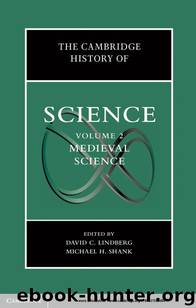The Cambridge History of Science: Volume 2, Medieval Science by David C. Lindberg & Michael H. Shank

Author:David C. Lindberg & Michael H. Shank [Lindberg, David C.]
Language: eng
Format: epub
Publisher: Cambridge University Press
Published: 2013-10-07T04:30:00+00:00
LATE LATIN TEXTS ON MEDICINE AND NATURAL SCIENCE
Although the same pattern of the coexistence of medical and scientific texts of various levels of sophistication and audience applied across the world of late antiquity, in general, medicine in the late antique West differed from its equivalent in the East in many ways. Galenism did not gain much hold. Only a handful of works by Galen and Hippocrates were translated into Latin, along with portions of Oribasius and Paul of Aegina, in all probability in the region of Ravenna. Indeed, by 800 Galen was most famous in Latin Europe as the inventor of a drug, the Hiera Galeni, or as the author of oracular precepts on uroscopy.19
In North Africa around 400, Methodist medicine appeared to be flourishing. Methodist theory, which went back to the first century, rejected humors in favor of explanations of the common features of illness in terms of the relationship between atoms and pores, expressed as fluidity, stricture, or a mixed state. The substantial treatise On Acute and Chronic Diseases by Caelius Aurelianus may be little more than a translation into Latin of a Greek book by Soranus of Ephesus around the year 100, but it is translated with flair and intelligence and shows traces of independent thought. Another North African, Cassius Felix, in 447 wrote a neat summary of therapeutics according to the principles of the “logical sect.” If one also adds the similar treatise that passes under the name of Vindicianus, the abundant information offered by St. Augustine on contemporary learned physicians and surgeons and their contacts with Alexandria, and the geographical and astronomical information collected by yet another African, Martianus Capella (ca. 470), the medical and scientific life of North Africa in the fifth century appears remarkably vibrant.20 Similar observations can be made about Italy, where the two most important surviving works of ancient veterinary medicine, by Pelagonius and Vegetius, were written toward the end of the fourth century and where the senator Macrobius included a long section on the physiology of eating and drinking in his Saturnalia, written around 430. Although they take much of their information from other authors, they organize it into a coherent and effective whole, and the veterinary authors in particular often describe their personal experiences in practice. The senator Cassiodorus, expounding to King Theodoric in around 520 the duties of the count of the archiatri, the chief of the doctors of Rome, describes a paragon of medical and scientific virtue, capable of judging all medical disputes, treating the king, and deciding on the capabilities of lesser colleagues, just as in Constantinople.21
But signs of decline are also apparent. Cassiodorus himself (ca. 490–590), when advising the monks of his monastery at Vivarium in southern Italy to aid the sick with medicines and with hope in God, also recommended to them a small selection of essential medical texts – Gargilius Martial's On Gardens, some Latin versions of Hippocrates and Galen's Method of Healing, for Glaucoma, an anonymous compendium, an (illustrated ?) Dioscorides, Caelius
Download
This site does not store any files on its server. We only index and link to content provided by other sites. Please contact the content providers to delete copyright contents if any and email us, we'll remove relevant links or contents immediately.
Learning SQL by Alan Beaulieu(6209)
Weapons of Math Destruction by Cathy O'Neil(6142)
Digital Minimalism by Cal Newport;(5663)
iGen by Jean M. Twenge(5366)
Sapiens by Yuval Noah Harari(5293)
The Age of Surveillance Capitalism by Shoshana Zuboff(4209)
Elon Musk by Ashlee Vance(4027)
Thing Explainer by Randall Munroe(3877)
Apollo 8 by Jeffrey Kluger(3635)
Future Crimes by Marc Goodman(3531)
The Science Book (Big Ideas Simply Explained) by DK(3233)
Who Can You Trust? by Rachel Botsman(3086)
Infinite Energy Technologies by Finley Eversole(2938)
I Live in the Future & Here's How It Works by Nick Bilton(2934)
Steve Jobs by Walter Isaacson(2830)
The Innovators: How a Group of Hackers, Geniuses, and Geeks Created the Digital Revolution by Walter Isaacson(2829)
Dawn of the New Everything by Jaron Lanier(2737)
Chernobyl by Serhii Plokhy(2497)
Ben Franklin's Almanac by Candace Fleming(2466)
